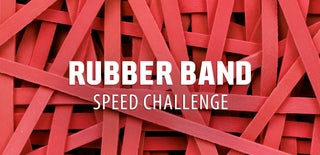Introduction: Rubber Band Wallet || Simple, Fast, Secure
Tired of struggling with a bulky, cumbersome, boring wallet every time you want to shop? Well, those days are over with the new Rudder Band Wallet® by 3llogical. Its open design allows for easy access to bills, credit cards, and gift cards whenever you need them. Plus, its simplicity permits as low as 1 hour print times, you heard me, 1 HOUR! That's right, you now have a fully customizable, instant wallet whenever needed, and even more exciting... It is free for a limited time, so order now! Now! Now! Now!
Supplies
- filament (I chose PLA)
- rubber bands
Step 1: Slicing
I used Fusion 360 and Cura to design and slice the model, due to the fact that they are free and reliable.
The settings I used were:
- .2 mm layer height
- 200 C temperature
- 100% infill
- ✓ Supports
- ✓ Skirt
Extra Tip: Scale the Z-axis as you wish, the thicker the stronger, the thinner and faster. Of course, this value should depend on your salary, if you know what I mean.
Step 2: Printing
I used a CR-10 to print the sliced model because of its cheap prices and, well, it is the only printer I have. At least for the moment... Wait, a few months, the answer will probably be different then.
Also, I used PLA 1.75 mm filament in white, because it seems to go with just about anything, but the choice is yours. However, I recommend sticking to easy-printing plastics as this wallet is large and wide, perfect for warping.
Extra Tip: Stop the print whenever you wish, again, the thicker the stronger, the thinner and faster.
Step 3: Assembling
I used 60 mm diameter rubber bands (I obviously do not know how the rubber band system works). They fit great around the 3D printed shape, keeping the just the right tension so that they do not fall off or strangle my money. The colors I used are interchangeable, I just thought the primary colors of red, blue, and yellow (yes, I passed pre-school) suited the white plastic well.
Also, I used a simple X pattern on the back because, to be honest, that the only one I knew how to do. But, I assume that with a bit of fiddling, more complex and interesting patterns could be formed. However, please note that the design was made for 3 rubber bands wrapped around twice, that is why you see 3 groups of 2 notches.
Step 4: Finishing
You are done! I am guessing it only took around an hour including printing, how about that! Remember, you can always swap the rubber bands to suit your needs whether they be tighter or looser, or stylish or casual. The decision is up to you.
Anyways, I hope you found the tutorial useful, and that this wallet helps you do the little things better.
Of course, the file is linked down below.
Please vote for this instructable in the rubber band contest. Thank you.
Attachments

Participated in the
Rubber Band Speed Challenge












